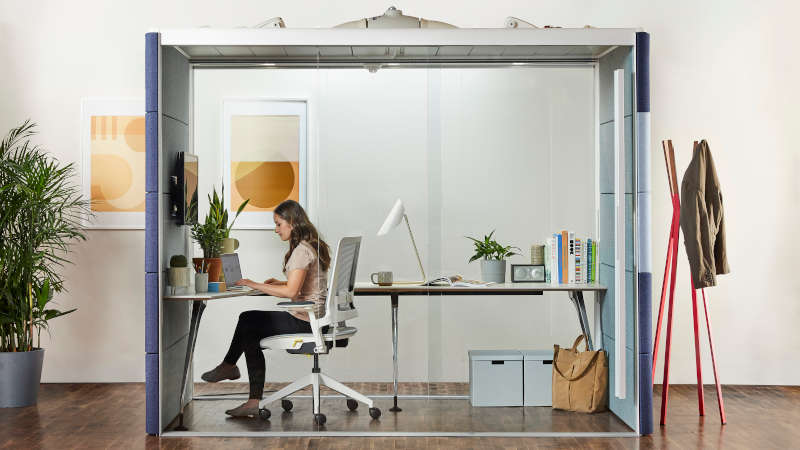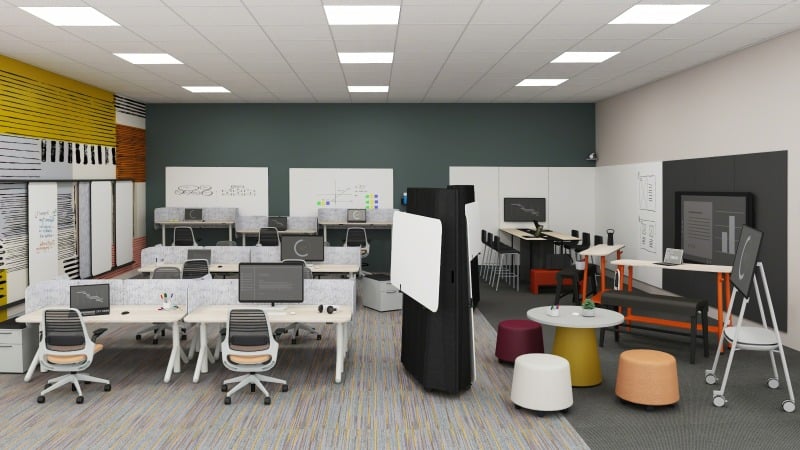In the midst of so much change, Steelcase’s research shows that people are struggling, even despite having more flexible work arrangements. Connection to culture, work-life balance and productivity is down. And all of this is making people more likely to leave.
Leaders are naturally worried. But why is all of this happening?
The latest edition of Steelcase’s Work Better magazine 'Hybrid work: 99 things you need to know now' explores how work is changing and how to make it better. We’ve picked out 10 of their 99 insights to share with you in this blog post.
1. Hybrid adoption varies significantly by country (and culture).
Steelcase research found that 70% of employees globally are working three days or more in the office, on average. But there is a lot of variation across countries.
In the UK, the split between office and remote work is more even - 53% spend more time in the office, with the other half of the population working more often at home. Meanwhile, people in China work almost exclusively from the office while Canada has the highest levels of remote work.
2. Over half of all meetings - 56% if not more - are spent on video.
Hybrid collaboration spaces must ensure all individuals can participate fully, whether they are in the office or joining remotely. Individual spaces for video meetings where people can hear and communicate easily without disturbing others are equally important.
To improve the hybrid meeting experience:
- Consider the room’s layout so everyone faces the camera
- In enclosed spaces, centre the camera in the room to ensure everyone at the table is in the field of view
- Focus on speech clarity and privacy, as well as limiting the spread of sound and echos with fabric wall panels, carpet and softer seating
- Provide multi-faceted lighting of the space, people and background
.jpg?width=800&height=450&name=My%20project-1%20(48).jpg)
3. The workplace needs four essential space types to support different kinds of work.
The four spaces every office should have are:
- Personal spaces - A range of spaces balancing the needs of ‘me’ and ‘we’ gives people control over their privacy and comfort.
- Collaboration spaces - Flexible settings, mobile tools and technology support in-person and distributed teams of all sizes.
- Social spaces - An intentional and flexible mix of shared and individual experiences foster a sense of community and belonging.
- Learning spaces - High-performing, adaptable spaces deliver integrated learning opportunities for in-person and distributed groups.
"People tell us they come to the office to collaborate and engage in social interactions. And yet the research says they also want the office to help them get their individual work done and provide privacy for focused work and better technology."
4. People spend the largest portion of their day doing focus work - 53% of time is spent working alone.
The office isn’t just for collaboration. People also need spaces where they can go to think, clear their heads and focus more deeply. It’s a must-have for workers today, who would rather sacrifice remote work days for an assigned, private desk in the office.
Interestingly, leaders have more access to privacy, yet spend less time working alone than individual contributors.
When designing focus spaces:
- Offer a variety of privacy options, e.g. fully enclosed enclaves, pods, screens, and shelves
- Supply a range of seating to support different types of work
- Provide height-adjustable seats so people can use the space comfortably
- Consider external monitors to make it easier to toggle between tasks and share content on video

5. People come to the office for a purpose.
The reasons people come to the office are:
- Collaboration
- Focus work
- Access to tools and technology
- Sense of belonging
- Feeling of shared purpose
- Connect with leaders
- Socialise and have fun
The office must be able to support all of these needs.
6. If you're not sure where to start with redesigning your office - run a pilot.
If you're looking to evolve your hybrid workplace, try out new spaces on a smaller scale and gather feedback first. Consider re-imagining unused spaces as social hubs with various settings to accommodate different types of work throughout the day.
And instead of making costly architectural changes, opt for flexible furniture that can be easily re-arranged. This way you can quickly create new spaces and redeploy assets as needed, giving your workplace the adaptability it needs to thrive.
7. Learning impacts retention.
“Learning is the new pension. It’s how you create future value every day.”
Providing employees with opportunities for learning and career development plays a major role in attracting and retaining talent. However, many companies are failing.
- 56% of employees and 68% of business decision-makers say there are not enough growth opportunities to entice them to stay in the long term
- Worryingly for employers, 55% feel that the best way to develop their skills is to change companies

8. Gen Z is reshaping the workplace.
Gen Z will represent almost a third of the global workforce by 2025 and will play a significant role in shifting attitudes and perceptions.
Currently, they are spending more time in the office than other generations.
"Gen Z values the office and expects it to support both the need to be together and to work alone."
Improvements will motivate them to show up even more. However, if they believe their salary or opportunities are lacking, they’ll be the most likely to leave.
9. Colour is a key ingredient to creating an inviting office space.
Organisations are moving away from cold colours that signal “it’s all business here” to warmer neutrals with a nod to the natural world. These colours provide a similar level of comfort to the home and make people feel good.
Steelcase has recently broadened its range of melamine solid colours by introducing eight new decors that exhibit softer, more subdued tones, drawing inspiration from the beauty of the natural world.

10. Inclusive design involves engaging the perspectives of a broad range of people.
Leaders and designers want to create inclusive workspaces, but many don’t have a shared understanding of what that really means.
To create a truly inclusive space, we need to engage the perspectives of people from different socioeconomic backgrounds, races, disabilities, ages, sizes and genders, and those who identify as neurodivergent.
In particular, design should pay attention to workers who have experienced exclusion or marginalisation in the workplace.
Summary
How we work has changed dramatically, no matter where you work and on which days. And as work continues to evolve, organisations must adapt to meet the changing needs of their employees.
Steelcase’s research highlights several eye-opening insights for creating better work environments. By incorporating these insights, organisations can create workspaces that foster productivity, engagement, and a sense of belonging.









